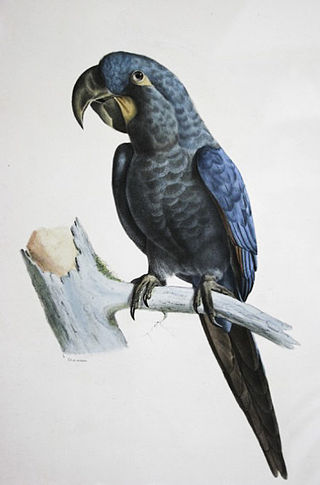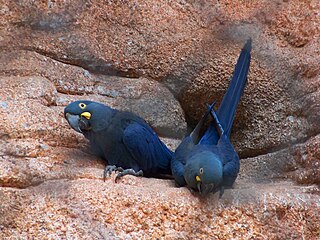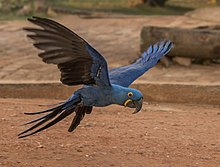
Macaws are a group of New World parrots that are long-tailed and often colorful, in the tribe Arini. They are popular in aviculture or as companion parrots, although there are conservation concerns about several species in the wild.

The palm cockatoo, also known as the goliath cockatoo or great black cockatoo, is a large smoky-grey or black parrot of the cockatoo family native to New Guinea, Aru Islands, and Cape York Peninsula in Queensland, Australia. It has a very large black beak and prominent red cheek patches.

Spix's macaw, also known as the little blue macaw, is a macaw species that was endemic to Brazil. It is a member of tribe Arini in the subfamily Arinae, part of the family Psittacidae. It was first described by German naturalist Georg Marcgrave, when he was working in the State of Pernambuco, Brazil in 1638 and it is named for German naturalist Johann Baptist von Spix, who collected a specimen in 1819 on the bank of the Rio São Francisco in northeast Bahia in Brazil. This bird has been completely extirpated from its natural range, and following a several-year survey, the IUCN officially declared it extinct in the wild in 2019. However, after over 20 years of conservation efforts, 200 macaws have been bred from just two parent birds, and 52 individual birds have since been reintroduced into their natural environment in June 2022.

Anodorhynchus is a genus of large blue macaws from open and semi-open habitats in central and eastern South America. It includes two extant species, the hyacinth macaw and Lear's macaw also known as the indigo macaw, and one probably extinct species, the glaucous macaw. At about 100 centimetres (39 in) in length the hyacinth macaw is the longest parrot in the world. Glaucous and Lear's macaws are exclusively cliff nesters; hyacinth macaws are mostly tree nesters. The three species mainly feed on the nuts from a few species of palms.

The glaucous macaw is a critically endangered or possibly extinct species of large, blue and grey South American parrot, a member of a large group of neotropical parrots known as macaws. This macaw is closely related to Lear's macaw and the hyacinth macaw. In Guaraní, it is called guaa-obi after its vocalizations.

The scarlet macaw is a large yellow, red and blue Neotropical parrot native to humid evergreen forests of the Americas. Its range extends from southeastern Mexico to Peru, Ecuador, Colombia, Bolivia, Venezuela and Brazil in lowlands of 500 m (1,600 ft) up to 1,000 m (3,300 ft), the Caribbean island of Trinidad, as well as the Pacific island of Coiba. Formerly, the northern extent of its range included southern Tamaulipas. In some areas, it has suffered local extinction because of habitat destruction, or capture for the parrot trade, but in other areas, it remains fairly common. It is the national bird of Honduras. Like its relative the blue-and-yellow macaw, the scarlet macaw is a popular bird in aviculture as a result of its striking plumage.

Lear's macaw, also known as the indigo macaw, is a large all-blue Brazilian parrot, a member of a large group of neotropical parrots known as macaws. It was first described by Charles Lucien Bonaparte in 1856. Lear's macaw is 70–75 cm long and weighs around 950 g. It is coloured almost completely blue, with a yellow patch of skin at the base of the heavy, black bill.

The red-and-green macaw, also known as the green-winged macaw, is a large, mostly-red macaw of the genus Ara.

The blue-and-yellow macaw, also known as the blue-and-gold macaw, is a large Neotropical parrot with a mostly blue dorsum, light yellow/orange venter, and gradient hues of green on top of its head. It is a member of the large group of neotropical parrots known as macaws. It inhabits forest, woodland and savannah of tropical Central and South America, as well as the island of Trinidad in the Caribbean. They are popular in aviculture because of their striking color, ability to talk, ready availability in the marketplace, and close bonding to humans.

The blue-throated macaw, also known as the Caninde macaw or Wagler's macaw, is a macaw endemic to a small area of north-central Bolivia, known as Los Llanos de Moxos. In 2014 this species was designated by law as a natural patrimony of Bolivia. Until 2010, it was hunted by native people to make feathered "Moxeño" headdresses for "machetero" ritual dances.

The red-bellied macaw, also known as Guacamaya Manilata, is a medium-sized, mostly green parrot, a member of a group of large Neotropical parrots known as macaws. It is the largest of what are commonly called "mini-macaws". The belly has a large maroon patch which gives the species its name.

The toco toucan is a species of bird in the toucan family Ramphastidae. It is the largest species of toucan and has a distinctive appearance, with a black body, a white throat, chest and uppertail-coverts, and red undertail-coverts. Its most conspicuous feature is its massive beak, which is yellow-orange with a black base and large spot on the tip. It is endemic to South America, where it has a wide distribution from the Guianas south to northern Argentina and Uruguay, and its range has recently been expanding southwards. Unlike other toucans, which inhabit continuous forests, toco toucans inhabit a variety of semi-open habitats at altitudes of up to 1,750 m. They are especially common in the Brazilian cerrado, gallery forests, and the wetlands of the Pantanal.

The military macaw is a medium- to larger-sized macaw, named after its green and red plumage vaguely resembling a military uniform. It is native from west-central México south through northern Argentina and Bolivia. While most wild populations are currently listed by the IUCN as vulnerable—and listed as endangered by México—, the species is still seen commonly in zoos and parks worldwide. The military macaw may be bred in captivity with relative ease, and is usually available through the pet trade. It is among the longest-lived and most expensive bird species one can own, requiring advanced knowledge, experience and confidence to keep them healthy, stimulated and thriving.

The great green macaw, also known as Buffon's macaw or the great military macaw, is a critically endangered Central and South America parrot found in Nicaragua, Honduras, Costa Rica, Panama, Colombia and Ecuador. Two allopatric subspecies are recognized; the nominate subspecies, Ara ambiguus ssp. ambiguus, occurs from Honduras to Colombia, while Ara ambiguus ssp. guayaquilensis appears to be endemic to remnants of dry forests on the southern Pacific coast of Ecuador. The nominate subspecies lives in the canopy of wet tropical forests and in Costa Rica is usually associated with the almendro tree, Dipteryx oleifera.

The blue-headed macaw or Coulon's macaw is a macaw native to eastern Peru, northwestern Bolivia, and far western Brazil. It has a total length of about 41 cm (16 in), making it a member of the group of smaller macaws sometimes known as the mini-macaws, which includes any species of macaw with a total length of 50 cm (20 in) or less. As in all macaws, its tail is long and pointed and the bill is large and heavy.

The Guadeloupe amazon or Guadeloupe parrot is a hypothetical extinct species of parrot that is thought to have been endemic to the Lesser Antillean island region of Guadeloupe. Mentioned and described by 17th- and 18th-century writers, it received a scientific name in 1789. It was moved to the genus Amazona in 1905, and is thought to have been related to, or possibly the same as, the extant imperial amazon. A tibiotarsus and an ulna bone from the island of Marie-Galante may belong to the Guadeloupe amazon. In 1905, a species of extinct violet macaw was also claimed to have lived on Guadeloupe, but in 2015, it was suggested to have been based on a description of the Guadeloupe amazon.

San Matías Integrated Management Natural Area is a protected area in Bolivia located in the Santa Cruz Department.

Sterculia apetala, commonly known as the Panama tree, camoruco, manduvi tree or anacagüita, is a species of flowering plants in the family Malvaceae. It is found in Central and South America, as well as the Caribbean islands. Sterculia apetala is recognized as the national tree of the Republic of Panama.
Charles A Munn III is an American conservation biologist and ecotourism entrepreneur. Munn is the founder and owner of SouthWild, a conservation-based ecotourism company that offers photography safaris throughout South America. In 2013, Condé Nast Traveller listed him as one of worlds's three leading experts on wildlife tourism, and the only one for South America. From 1984-2000 he was a conservation field biologist with the Wildlife Conservation Society. He also founded Peru Verde Conservation Group, the BioBrasil Foundation, and Tropical Nature Conservation Group. Munn is an American citizen but spends most of his time in Brazil and Chile. He is based in the Mato Grosso state.
Neiva Maria Robaldo Guedes, or Neiva Guedes, is a Brazilian biologist and a specialist on environment and species conservation.





























